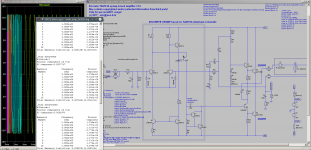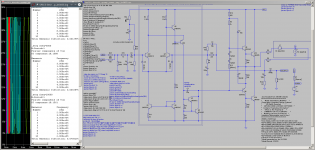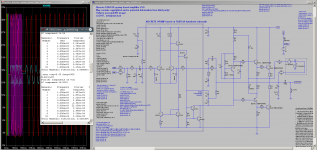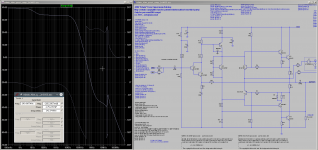Vintage series: discrete TAA761A opamp - 2N3055 quasi compl. amplifier - 25W@4R
I always wondered how one of my first amplifier builds based on TAA761A/2N3055 quasi complementary amplifier performed, which I have build around 1979/80.
The original schematic is lost - I have redrawn this as good as I could remember. The original design was powered from a single 35V regulated power supply with integrated overcurrent shutdown. The amplifier survived every disco party at that time - only one treble speakers has gone forever ...
The TAA761 +input was biased to 1/2 of 35V and the speaker was connected via a 2200µF capacitor to ground.
Using discrete parts the power supply isn't as critical as using the original TAA761A which was limited to max. 36V.
The TAA761A has had a slew rate around 9Vµs.
Attached a simulation just4fun. Shown schematic is completely untested!
BR, Toni
Fix errata: titel power is wrong! Output power is about 25 - 30W@4R
I always wondered how one of my first amplifier builds based on TAA761A/2N3055 quasi complementary amplifier performed, which I have build around 1979/80.
The original schematic is lost - I have redrawn this as good as I could remember. The original design was powered from a single 35V regulated power supply with integrated overcurrent shutdown. The amplifier survived every disco party at that time - only one treble speakers has gone forever ...
The TAA761 +input was biased to 1/2 of 35V and the speaker was connected via a 2200µF capacitor to ground.
Using discrete parts the power supply isn't as critical as using the original TAA761A which was limited to max. 36V.
The TAA761A has had a slew rate around 9Vµs.
Attached a simulation just4fun. Shown schematic is completely untested!
BR, Toni
Fix errata: titel power is wrong! Output power is about 25 - 30W@4R
Attachments
Last edited:
Interesting beast, this young whippersnapper never heard of that IC. I would presume the transistors in the TAA761 have more to do with BC547 or the like than 2N5551, which are highish voltage types. An electrolytic across the bias network would seem worth a shot, and the Baxandall diode arguably better be something a little beefier than 1N4148. Actually going with much beefier diodes in the bias might just enabling going with three of 'em. Experimenting with external impedances also seems worth a shot, I very much doubt the input pair is balanced particularly well.
C5 should have positive end to ground.
I slipped up on that when I made my first quasi.
Because the output drivers aren't symmetrical there is a negative voltage fed back to the ltp on no AC signal.
Q6 will probably need 100pf from base to collector to stop oscillation.
You might also find you need 10R base stoppers on the 2n3055.
The 2n3055 brings back happy memories of the Maplin 225WRMS disco amplifier I built in 1980. It worked very well and was very loud.
I slipped up on that when I made my first quasi.
Because the output drivers aren't symmetrical there is a negative voltage fed back to the ltp on no AC signal.
Q6 will probably need 100pf from base to collector to stop oscillation.
You might also find you need 10R base stoppers on the 2n3055.
The 2n3055 brings back happy memories of the Maplin 225WRMS disco amplifier I built in 1980. It worked very well and was very loud.
Warm fuzzy memories.
Built some 8000 2N3055 based amplifiers between 1970/72 and 2008, go figure. 🙂
Built some 8000 2N3055 based amplifiers between 1970/72 and 2008, go figure. 🙂
Now with TMC compensation. Better bias circuit. 100mA OPS bias.
Discrete TAA761A opamp slew rate like datasheet (~10V/µs).
Seems stable. Who want to breadboard test it? 😉
BR, Toni
Discrete TAA761A opamp slew rate like datasheet (~10V/µs).
Seems stable. Who want to breadboard test it? 😉
BR, Toni
Attachments
This smells like fun ...I still might have some of these open collector TAA761's laying in my drawers...
Best regards!
😀
Only found one TAA761A - looks like it could be defect...
The TAA861 only withstand max. 20V but may be good enough for a test.
Don't know from where I got the TAA861...
Found some vintage MJ2955 and some Sanken complementary power transistors too...
Does anybody know the vendor TP / 2N3055 (text "MEXICO" on pin side)?
BR, Toni
The TAA861 only withstand max. 20V but may be good enough for a test.
Don't know from where I got the TAA861...
Found some vintage MJ2955 and some Sanken complementary power transistors too...
Does anybody know the vendor TP / 2N3055 (text "MEXICO" on pin side)?
BR, Toni
Attachments
Be cautious! TAA761 and TAA861 are pin compatible, BUT only TAA761 features the open collector output that is needed here.
Best regards!
Best regards!
Interesting... datasheets show same internal schematic. both need RL from pos. supply to output...
BTW: TAA861 has also lower power dissipation. But when I would build it on breadboard I would build the discrete variant ...😉
BTW: TAA861 has also lower power dissipation. But when I would build it on breadboard I would build the discrete variant ...😉
Here an example of a bad designed amplifier. (from an Oppermann Catalog from 81 as far as I know - I only own a photo copy from those page; from this amplifier I have taken the idea to the quasi complementary output stage for the TAA761A based amp.)
=> bad phase/gain margin. I can remember that this amplifier was a radio sender from first powering till I added a 20pF capacitor from base to collector of Q12 ... 😱
BR, Toni
=> bad phase/gain margin. I can remember that this amplifier was a radio sender from first powering till I added a 20pF capacitor from base to collector of Q12 ... 😱
BR, Toni
Attachments
This amplifier was *iirc* designed by ELEKTOR as one of their first AF power amplifier projects and named EDWIN. I built two of them for a friend by assembling Oppermann kits in about 1975 and never had any issues with them. Strange, isn't it?
Best regards!
Best regards!
Maybe the kit provided different parts/values as printed in the catalog? IMHO this is one of the designs which worked by accident and/or was heavy dependend on the used transistors at that time. I remember I have used BC237B ... with those "better" transistors I needed the input miller cap to get it stable...😱This amplifier was *iirc* designed by ELEKTOR as one of their first AF power amplifier projects and named EDWIN. I built two of them for a friend by assembling Oppermann kits in about 1975 and never had any issues with them. Strange, isn't it?
Best regards!
I 've alwas thought that BC107B, BC182C, BC237B, BC547B and many others are/were equivalent, with the exception of their packages?
Still own the schematics and build advice of that EDWIN somewhere and will have a look tomorrow.
Best regards!
Best regards!
Still own the schematics and build advice of that EDWIN somewhere and will have a look tomorrow.
Best regards!
Best regards!
It is in all circuits the same value - no typo. If you simulate with higher values, the GM/PM doesn't better significant. It is always in the near of oscillation. You need to add at least 20pf at the darlington frontend to get a better GM/PM margin...12 pF seems way low for a Miller cap, might have been a typo?
Dear Kay,...
Still own the schematics and build advice of that EDWIN somewhere and will have a look tomorrow.
...
have you had some sparetime looking for the original build instructions/pcb layout?
BR, Toni
HI Toni,
yes, I've found it. Schematics is exactly the same as yours. No additional capacitors recommended in the advice.
Best regards!
yes, I've found it. Schematics is exactly the same as yours. No additional capacitors recommended in the advice.
Best regards!
- Status
- Not open for further replies.
- Home
- Amplifiers
- Solid State
- Discrete TAA761A opamp - 2N3055 quasi compl. amplifier - 50W@4R





